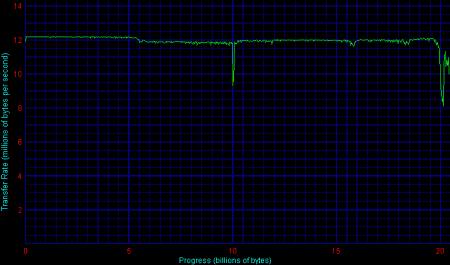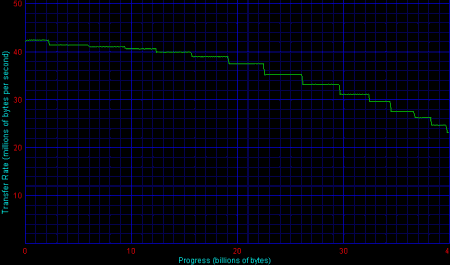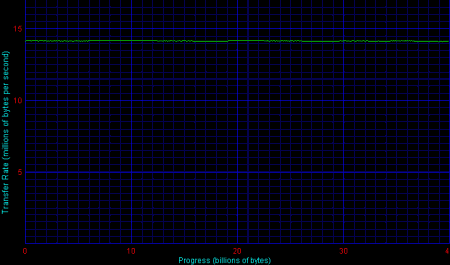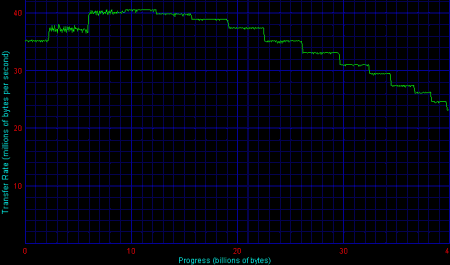Tests
Testbed configuration:
- MSI 6337 (Intel 815EP) mainboard
- Intel Celeron 566(850) MHz
- 256 MBytes SDRAM SEC PC133
- ATA100 (ICH2) controller
- USB 2.0 (NEC chip) controller
- FireWire (Lucent chip) controller
- Maxtor 6 L040J2 HDD, 40 GBytes
- Windows 98 SE, Windows 2000 (SP2)
- drivers for USB 2.0 bridge: ISD 5.04
The tests were carried out in the WinBench 99 ver. 2.0. Besides, we measured time of copying of two text file suites: 1 GBytes in one file and 1 GBytes in 9226 files.
Windows98 SE
The installation didn't cause any problems. The FireWire case was immediately identified by the system, and with the Fdisk utility I created one partition of the maximum size on the disc. Then it was formatted. When I was installing the USB 2.0 case the system decided to use the old drivers as before I had a USB1.1-IDE bridge from In-System. That is why I had to reinstall the drivers manually ("Properties/Driver/Update driver"). The partitioning and formatting processes were the same. For comparison we include test results of the hard drive connected directly to the ATA controller.
Winbench 99
Direct connection.
 Click to enlarge Click to enlarge
Via USB 2.0.
 Click to enlarge Click to enlarge
Via FireWire.
 Click to enlarge Click to enlarge
| Connection |
Direct |
USB 2.0 |
FireWire |
| Business Disk Winmark |
6510 |
4870 |
6040 |
| Hi-End Winmark |
21300 |
13900 |
18500 |
| Transfer start |
41700 |
12400 |
27400 |
| Transfer end |
25600 |
12300 |
25400 |
| CPU usage |
17% |
15,7% |
12% |
| Access time, ms |
12.5 |
13.3 |
12.8 |
Copying files
| Connection |
Direct |
USB 2.0 |
FireWire |
| 1GB in 1 file |
58.7 sec |
1m 54.6 sec |
1m 09.6 sec |
| 1GB in 9226 files |
1m 24.1 sec |
1m 59.4 sec |
1m 30.1 sec |
As you can see, the FireWire outscores the USB 2.0 in all WinBench tests, as well as in the file copying.
Windows 2000
The installation was similar to the Windows 98SE. The only difference is that the system doesn't format 40 GBytes drives under the FAT32. That is why we had to do it in the Windows 98 SE. After that we noticed no problems in the Windows 2000.
Winbench 99
Direct connection.
 Click to enlarge Click to enlarge
Via USB 2.0.
 Click to enlarge Click to enlarge
Via FireWire.
 Click to enlarge Click to enlarge
| Connection |
Direct |
USB 2.0 |
FireWire |
| Business Disk Winmark |
7870 |
8250 |
9650 |
| Hi-End Winmark |
26400 |
17500 |
18500 |
| Transfer start |
41900 |
14200 |
36100 |
| Transfer end |
25600 |
14200 |
25500 |
| CPU usage |
11.2% |
5.93% |
9.25% |
| Access time, ms |
13 |
12.9 |
12.6 |
Copying files
| Connection |
Direct |
USB 2.0 |
FireWire |
| 1GB in 1 file |
43.8 sec |
1m 20 sec |
48.9 sec |
| 1GB in 9226 files |
1m 15.4 sec |
1m 30 sec |
1m 18.4 sec |
Here the USB 2.0 comes very close to the FireWire in Winmark. However, the FireWire remains a leader.
After that I accomplished a few more tests of compatibility of some IDE devices with the bridge cards. I took a TEAC CD-W524E 24x CD-RW and a Pioneer M-500 DVD-ROM. After a bit of trouble with their connection (it's still hard to put a 5" device into a 3" case) everything worked flawlessly.
In both cases recording of the CD-R discs at the maximum speed (24x) was excellent, as well as recording of the DVD-ROM Pioneer. Below you can look at the results of copying of the CD and DVD onto the hard drive.
| Connection |
Direct |
USB 2.0 |
FireWire |
| DVD, 1GB in 1 file |
2m 51 sec |
2m 58 sec |
2m 43 sec |
| CD, 725MB in 6425 files |
4m 40 sec |
4m 38 sec |
4m 43 sec |
Conclusions
Although the USB 2.0 is speedier than the FireWire, the latter beats it when used in high-speed storage devices. Probably, future products will unveil and use the full potential of the USB 2.0 bus. If we take only the storage devices sphere, the optimal solution would be a combo USB 2.0/FireWire-IDE bridge. In this case a user would get the maximum flexibility when choosing the ways of connection of data storage devices.
Write a comment below. No registration needed!
|
|
 |
|
|
|
